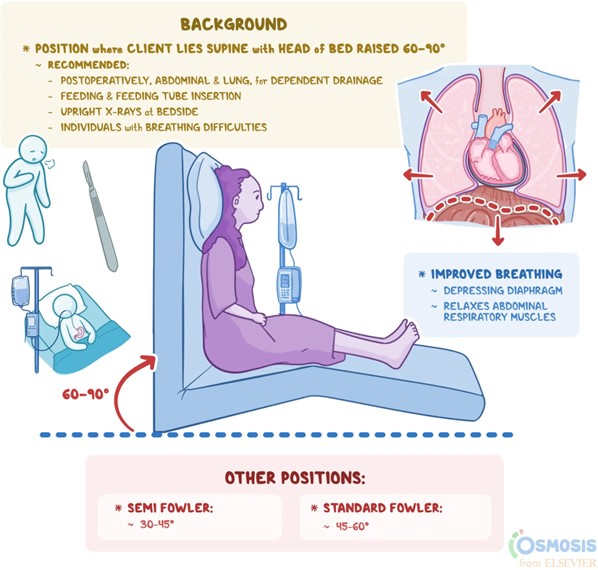A nurse is collecting data from a client who has heart failure. The nurse notes the client has crackles in the bases of the lungs and a respiratory rate of 24/min. Which of the following actions should the nurse take?
Increase the client's intake of oral fluids.
Instruct the client to cough every 4 hr.
Encourage the client to ambulate to loosen secretions.
Maintain the client in high-Fowler's position.
The Correct Answer is D
The client's crackles in the bases of the lungs and an increased respiratory rate indicate the presence of fluid accumulation in the lungs, which is commonly seen in clients with heart failure. Maintaining the client in a high Fowler's position helps to promote optimal lung expansion and ventilation by reducing the pressure on the diaphragm, allowing for improved breathing mechanics and enhanced oxygenation.

Increasing the client's intake of oral fluids: While maintaining hydration is generally important, increasing oral fluids may not directly address the issue of fluid accumulation in the lungs. The priority in this situation is to optimize the client's respiratory function.
Instructing the client to cough every 4 hours: Coughing alone may not be sufficient to resolve the fluid accumulation. The underlying cause of the crackles and increased respiratory rate in heart failure is fluid congestion, which requires more comprehensive management.
Encouraging the client to ambulate to loosen secretions: While ambulation is generally beneficial for clients with heart failure, it may not directly address the fluid accumulation in the lungs. Ambulation can help improve overall cardiovascular function and fluid balance, but in the presence of acute respiratory distress or significant fluid overload, the client may not be able to tolerate or benefit from ambulation immediately.
In addition to maintaining the client in a high-Fowler's position, the nurse should also collaborate with the healthcare provider to initiate appropriate interventions, such as administering diuretic medications to help remove excess fluid and improve respiratory status. Monitoring the client's oxygen saturation, providing supplemental oxygen as needed, and assessing other vital signs are also important aspects of care in managing heart failure-related respiratory symptoms.
Nursing Test Bank
Naxlex Comprehensive Predictor Exams
Related Questions
Correct Answer is D
Explanation
It is common for school-age children to exhibit magical thinking and believe that their actions or thoughts have the power to cause events, including the illness or death of a loved one.
Therefore, it would be expected for the school-age brother of a child with terminal cancer to have thoughts or beliefs that his own behavior is causing his brother's death. It is important for the nurse to provide age-appropriate education and support to help the brother understand the nature of the illness and address any misconceptions or feelings of guilt.
Correct Answer is ["A","B","C","D"]
Explanation
Provide the client with written information about advance directives: It is important for the nurse to educate the client about advance directives, their purpose, and how they can make informed decisions about their healthcare.
Instruct the client that an advance directive is a legal document and must be honored by care providers: The nurse should explain to the client that an advance directive is a legally binding document that guides healthcare decisions, and it must be respected and followed by healthcare providers.
Communicate advance directives status via the medical record and shift report: The nurse should ensure that the client's advance directives status is accurately documented in the medical record and communicated to other members of the healthcare team during shift handoffs. This helps ensure that the client's wishes are known and respected by all involved in their care.
Initiate a power of attorney for a healthcare document: The nurse can assist the client in initiating a power of attorney for a healthcare document if the client wishes to appoint someone as their healthcare proxy or agent. This document designates someone to make medical decisions on behalf of the client if they become unable to do so.
The other options listed are not appropriate or accurate in relation to the responsibilities of the nurse regarding advance directives:
- Document that the provider discussed do-not-resuscitate status with the client: While discussing do-not-resuscitate (DNR) status may be part of the advance care planning process, it is not directly related to advance directives as a whole.
- Inform the client that an advance directive discontinues further care: This statement is incorrect and misleading. An advance directive does not automatically discontinue care but rather guides the provision of care according to the client's wishes.
Whether you are a student looking to ace your exams or a practicing nurse seeking to enhance your expertise , our nursing education contents will empower you with the confidence and competence to make a difference in the lives of patients and become a respected leader in the healthcare field.
Visit Naxlex, invest in your future and unlock endless possibilities with our unparalleled nursing education contents today
Report Wrong Answer on the Current Question
Do you disagree with the answer? If yes, what is your expected answer? Explain.
Kindly be descriptive with the issue you are facing.
